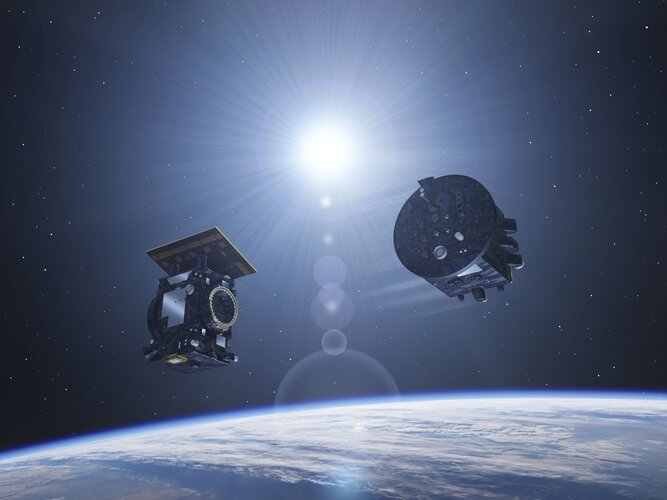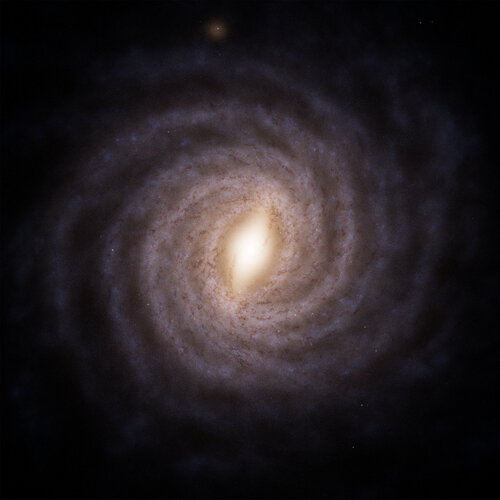
Copernical Team
The best Milky Way animation, by Gaia
 Video:
00:02:05
Video:
00:02:05
This is a new artist’s animation of our galaxy, the Milky Way, based on data from ESA’s Gaia space telescope.
Gaia has changed our impression of the Milky Way. Even seemingly simple ideas about the nature of our galaxy’s central bar and the spiral arms have been overturned. Gaia has shown us that it has more than two spiral arms and that they are less prominent than we previously thought. In addition, Gaia has shown that its central bar is more inclined with respect to the Sun.
No spacecraft can travel beyond our galaxy, so we can’t take a selfie, but Gaia
Snooping science on the Moon

The European Space Agency (ESA) has signed its first exploration data buy agreement with Hungarian company Puli Space Technologies, whose neutron spectrometer will study water ice in the Moon's south pole region and provide the first direct surface measurements from a permanently shadowed crater. Through this partnership, ESA will obtain data from the spectrometer, which will fly on Intuitive Machines' second lunar mission.
Proba-3 becomes two: satellites separated

Last night a crucial step in the European Space Agency’s eclipse-making Proba-3 mission was completed: the two spacecraft, flying jointly since launch, have successfully separated. This leaves them ready to begin their cosmic dance in the world’s first-ever precision formation-flying mission.
InCubed satellites launched to drive innovation in Earth observation
 Three satellites from ESA's InCubed programme have launched from Vandenberg Space Force Base, California, demonstrating the agency's commitment to fostering innovation and collaboration in the commercial space sector.
The InCubed initiative, which stands for 'Investing in Industrial Innovation,' is managed by ESA's Pi-lab and focuses on advancing commercially viable technologies that lever
Three satellites from ESA's InCubed programme have launched from Vandenberg Space Force Base, California, demonstrating the agency's commitment to fostering innovation and collaboration in the commercial space sector.
The InCubed initiative, which stands for 'Investing in Industrial Innovation,' is managed by ESA's Pi-lab and focuses on advancing commercially viable technologies that lever IRIDE Pathfinder satellite successfully deployed
 The first IRIDE satellite, known as the Pathfinder Hawk, has entered orbit following its launch aboard a SpaceX Falcon 9 rocket from Vandenberg Space Force Base in California on January 14. This event marks a significant step in advancing Earth observation capabilities.
Designed as a prototype, the Pathfinder Hawk is part of the IRIDE programme's ambitious plan to deploy six distinct satel
The first IRIDE satellite, known as the Pathfinder Hawk, has entered orbit following its launch aboard a SpaceX Falcon 9 rocket from Vandenberg Space Force Base in California on January 14. This event marks a significant step in advancing Earth observation capabilities.
Designed as a prototype, the Pathfinder Hawk is part of the IRIDE programme's ambitious plan to deploy six distinct satel Proba-3 satellites separate for precision space mission
 A major milestone in the European Space Agency's Proba-3 mission occurred last night as the twin spacecraft, launched together in December 2024, successfully separated. This marks the start of their unique role in the world's first precision formation-flying mission.
The Proba-3 satellites, launched on 5 December 2024 aboard a PSLV-XL rocket from India's Satish Dhawan Space Centre, had rem
A major milestone in the European Space Agency's Proba-3 mission occurred last night as the twin spacecraft, launched together in December 2024, successfully separated. This marks the start of their unique role in the world's first precision formation-flying mission.
The Proba-3 satellites, launched on 5 December 2024 aboard a PSLV-XL rocket from India's Satish Dhawan Space Centre, had rem Firefly Aerospace's Blue Ghost Mission 1 begins transit to the Moon
 Firefly Aerospace announced the successful launch of its Blue Ghost lunar lander on a SpaceX Falcon 9 rocket, marking the beginning of its 60-day mission. Following a 45-day transit to the Moon, the mission aims to deliver 10 instruments for NASA's Commercial Lunar Payload Services (CLPS) initiative. A target landing date of March 2, 2025, has been set.
Dubbed Ghost Riders in the Sky, Blue
Firefly Aerospace announced the successful launch of its Blue Ghost lunar lander on a SpaceX Falcon 9 rocket, marking the beginning of its 60-day mission. Following a 45-day transit to the Moon, the mission aims to deliver 10 instruments for NASA's Commercial Lunar Payload Services (CLPS) initiative. A target landing date of March 2, 2025, has been set.
Dubbed Ghost Riders in the Sky, Blue Gaia concludes Milky Way mapping efforts
 The European Space Agency's Milky Way-mapper Gaia has completed the sky-scanning phase of its mission, racking up more than three trillion observations of about two billion stars and other objects over the last decade to revolutionise the view of our home galaxy and cosmic neighbourhood.
Launched on 19 December 2013, Gaia's fuel tank is now approaching empty - it uses about a dozen grams o
The European Space Agency's Milky Way-mapper Gaia has completed the sky-scanning phase of its mission, racking up more than three trillion observations of about two billion stars and other objects over the last decade to revolutionise the view of our home galaxy and cosmic neighbourhood.
Launched on 19 December 2013, Gaia's fuel tank is now approaching empty - it uses about a dozen grams o ESA’s Highlights in 2025

This year will mark the European Space Agency’s 50th anniversary and promises to be a landmark year for the European aerospace industry. In addition to milestone events in our programmes, September will also mark 30 years of satellite navigation for Europe. This spring brings the second commercial mission involving a project astronaut to the International Space Station on Axiom Mission 4, while events such as ESA's Living Planet Symposium and the International Paris Air Show will gather the space community face to face.
Last starlight for ground-breaking Gaia

The European Space Agency’s Milky Way-mapper Gaia has completed the sky-scanning phase of its mission, racking up more than three trillion observations of about two billion stars and other objects over the last decade to revolutionise the view of our home galaxy and cosmic neighbourhood.
